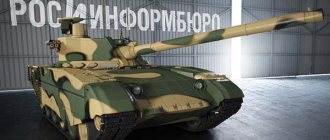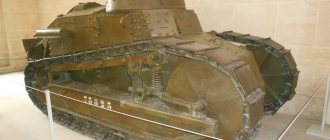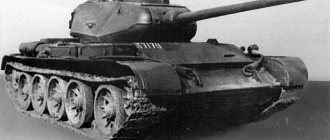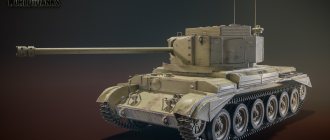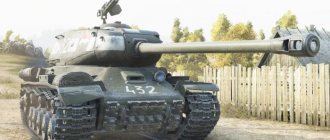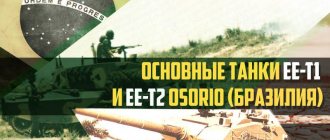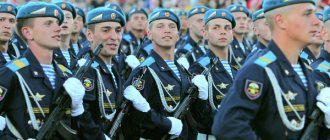Amphibious tanks of World War II
Home » Real story » Little-known and unrealized projects of tanks and other armored vehicles » Amphibious tanks of the Second World War
Little-known and unrealized projects of tanks and other armored vehicles Unrealized projects of tanks of the Third Reich and Germany.
Novik -007 09.11.2019 2248
2
to Favoritesin Favoritesfrom Favorites 1
The Germans began to think about crossing water barriers only when the only rivals left in Western Europe were Great Britain, located across the English Channel from recently captured France. On July 16, 1940, the German command adopted a plan for the invasion of German troops into England, which received the designation “Sea Lion” (Seelöwe). The plan included an amphibious landing on the British coast, and the Germans were afraid to leave their infantry without tanks on the British coast.
Pz II with swimming equipment during testing
They decided to conduct experiments on creating an amphibious tank on a light Pz II, armed with two weapons - a 20 mm automatic cannon and a machine gun. There were two options. One included a one-piece flat pontoon with a cutout in the middle that could be attached to the tank. The pontoon had a streamlined bow. Movement through the water was carried out using propellers driven by gears meshed with the tank tracks. This design allowed the Pz II to sail at a speed of 12.5 km/h. After reaching the shore, the floats were reset in no more than one and a half seconds. But another option was adopted - floats were put on the sides of the tank, attached to the extensions of the axes of the supporting rollers, and the hull was sealed. Movement through water at a speed of 10 km/h was carried out thanks to the rotation of the tracks, turning by stopping one of the tracks. The vehicle was named Swimpanzer II. In 1940, 52 tanks were converted, but it soon became clear that the landing in Britain was cancelled. Germany turned its gaze to the east - the 18th Tank Regiment, armed with the Swimmpanzer II, fought in the central sector of the Eastern Front. The tanks were used like regular Pz IIs. Similar experiments were carried out with the Czech tank in service with the Wehrmacht Pz 38, but such vehicles were not serially converted.
Floating version of the Pz 38
The Germans wanted to teach their tanks not only to swim, but also to dive. Also in 1940, in preparation for the Sea Lion, 168 Pz III tanks of modifications F, G, H, as well as some command tanks, were converted into the so-called Tauchpanzer III (“diving tank”), tanks equipped with equipment for underwater driving tank (OPVT). It was planned to deliver the tanks by barge to the coast of Great Britain, lower them to the bottom of the English Channel, from where they would reach the treasured shore under their own power and enter into battle. To do this, the air intakes were closed, the exhaust pipe was equipped with a valve, and all cracks were sealed with special rubber pads. Air entered the tank through a snorkel - a special tube with a float. The radio antenna remained above the water. For navigation under water there was a hydrocompass. The tank could drive along the bottom at depths of up to 15 m, and before diving it was necessary to conduct bottom reconnaissance. During the dive, the loader was required to monitor the carbon monoxide content in the air inside the tank. If the concentration of CO in the fighting compartment exceeded, the crew had to leave the vehicle through the hatches and surface, having previously flooded the vehicle in order to equalize the pressure inside and outside. Since July 1940, four squads underwent intensive training on these machines on the island of Sylt. With the abandonment of the landing in Great Britain, it was decided to use these tanks to cross rivers along the bottom during the upcoming war with the USSR. At the Milovice plant in the Czech Republic, tanks were converted to cross rivers by installing a fixed snorkel on the roof of the commander's cupola. In October 1940, three of the four trained squads became part of the 18th Tank Regiment of the 18th Tank Division, and another in the 6th Tank Regiment of the 3rd Tank Division. On the day of the attack on the USSR, at 4:45 a.m., vehicles of the 18th Panzer Division crossed the Western Bug River along the bottom near Brest. This moment is shown in the epic film “Liberation”. According to information from a German tankman captured by the Americans on December 1, 1944 in Saarbrücken, “diving” Pz IIIs were also used when crossing the Dnieper. In that place, the Dnieper was 3 km wide and 10-15 meters deep. Two tanks got stuck in the mud and were temporarily out of action.
Tauchpanzer III in testing
42 Pz IV (Tauchpanzer IV) tanks were converted to the same model. Together with the diving Pz IIIs, they took part in the crossing of the Western Bug. Subsequently, all “diving” tanks, as a rule, were used as usual or for the purpose of researching technologies for crossing water obstacles along the bottom.
Based on the successful, but not widespread use of tanks equipped with OPVT, it was decided to install it on all production tanks in Germany. The tanks became heavier, and the number of bridges that could support them decreased accordingly. However, by the time the first production tank Pz V “Panther” was created, the OPVT was not ready for it, although even without it the tank could overcome fords up to 1.9 m deep. The command allowed the first 50 tanks to be delivered without OPVT while the corresponding equipment was being created. The engine compartment was sealed with a flange, and air was taken in through a telescopic pipe. However, it soon became clear that the pipe had leaks, and the standard 16-ton sapper bridge could easily withstand the Panther, and from July 1943, in order to reduce the cost, these tanks began to be produced without OPVT.
Even heavier Pz VI Tigers were also equipped with OPVT. The air entered through a snorkel located at the rear of the tank on the right, all cracks were sealed with rubber gaskets, and before entering the water, the cooling radiators were dismantled, and the radiator compartments were filled with water. The first 495 of a total of 1,355 vehicles were produced with such equipment. The engine was already unable to effectively pull the mass of the tank, and the OPVT only worsened the situation. Many crews themselves dismantled this equipment in the field.
Tiger tank with underwater driving equipment
The same equipment was installed on several early Pz VII "Royal Tigers" and was even planned for installation on the experimental heavy "Mouse".
Despite this, the experience of using tanks with OPVT was used in post-war tank building, and to this day almost all modern tanks have similar equipment.
The Germans wanted to give the ability to cross bodies of water not only to tanks.
Amphibious tractor LWS
In 1936, she received an order for a floating tractor (essentially an amphibious tractor). It was intended to be used as a tractor on land, and as a tug on water. However, the prototype was created only in the spring of 1940. The vehicle received the index LWS (Land-Wasser-Schlepper - tractor for land and water) and was something like a boat with a caterpillar propulsion system. Two propellers made it possible to move through the water. Maybach HL120TRM engine with 300 hp power. (the same as the Pz III and Pz IV tanks) was located under the floor of the troop compartment and allowed the 13-ton vehicle to move through water at a speed of 12.5 km/h, and on land at 35 km/h. Cruising range on land is 350 km. The crew consisted of 3 people. The LWS could carry 20 fully equipped paratroopers. In the spring of 1940, 7 vehicles were produced; there is information about their use in the campaign in Western Europe. Another 14 vehicles were ordered for landing in the UK. Later they fought on the Eastern Front, in particular they took part in the landing on the Moosund Islands in the Baltic Sea, and were also seen in northern Africa. Later, special trailers were created that had a boat-like hull with a hinged rear ramp through which a tank or truck weighing up to 20 tons could enter the trailer. In 1944, they participated in the evacuation and supply of German troops from the pockets in Danzig and Prussia.
LWS on shore
In 1938, the Wehrmacht adopted two floating all-wheel drive passenger cars - the Schwimmwagen (floating vehicle) and Hans Trippel's SG-6. The first was made on the basis of the Kubelwagen army vehicle. The body was made of sheet steel 1 mm thick. Air-cooled boxer engine with 25 hp power. was located at the back. Movement through the water was carried out using a three-bladed propeller, and turns were carried out using wheels. The maximum speed on land is 80 km/h, on water – 10 km/h. From the autumn of 1942 to the summer of 1944, a total of 14,300 Schwimmwagen vehicles were produced. Thus, this is the most massive amphibious vehicle in the history of mankind. In addition, it is also one of the best passenger cars of the Second World War. The troops loved it for its good maneuverability, which was especially important in the conditions of the Eastern Front. Watercraft, as a rule, was used only in peaceful situations. Interestingly, there were rumors that after the Allied landings in Normandy, American officers gave three jeeps at once for a captured Schwimmwagen.
Swimmwagen
The Triple SG-6 was developed in 1934 and was the first commercial amphibious vehicle. The car was driven by a 4-cylinder Adler engine or a 6-cylinder engine from an Opel Captain. While afloat, the SG-6 moved with the help of a propeller, which, in the land position, rose up 120 degrees and retracted into the recess of the body. At the rear of the hull there was a deck on which an anchor, two oars and a lifebuoy were attached. The car could reach speeds of up to 13 km/h afloat, and about 80 km/h on the highway. The carrying capacity was 1 ton. In 1938, the vehicle was put into service and 1,000 copies were produced. In 1942-1944, experimental amphibious armored vehicles “Schildkrete” (“Turtle”), armed with a machine gun or 20-mm cannon, were created on its basis, but these vehicles did not go into production.
Hans Trippel's floating car
So, the Germans did not create a serial amphibious tank, but they gave the world the OPVT concept, which is used to this day. To be fair, we note that most often, engineering units armed with bridge-laying tanks and other special equipment were used to force water obstacles.
The review seems complete. I apologize if I’m “boyan”, I checked, there doesn’t seem to be any information like this on the thread.
Was there a secret squadron or "Squadron A"?
No, they did not exist as regular organizational structures.
Where have dozens and even hundreds of cargo submarines disappeared from the dock slipways? First, they did not exist in such quantities. Second, many remained projects. As we see, everything is much simpler and without any mysticism.
So, the final figures for all types of submarines of the German Navy:
A total of 1,170 submarines were commissioned, including 21 from other countries (British, Turkish, Danish, French and Italian). They did not include 10 experimental submarines (U-791-800) of the Walter class.
